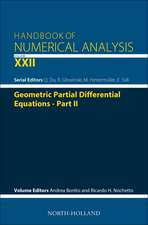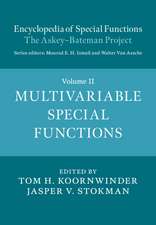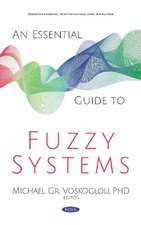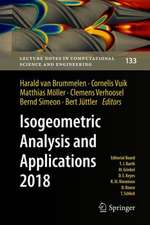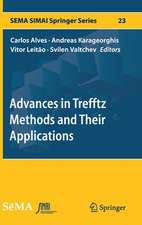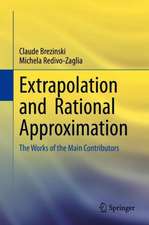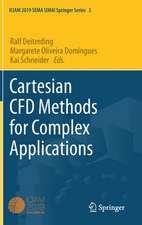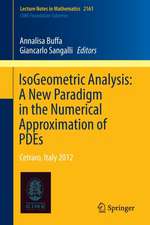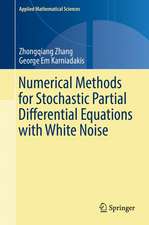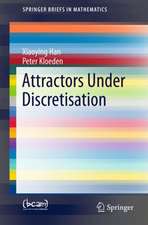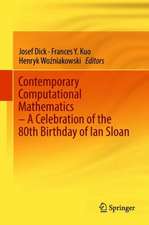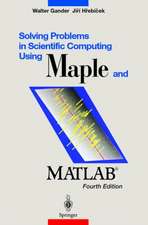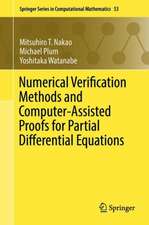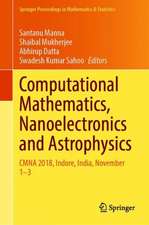Scientific Computing - An Introduction using Maple and MATLAB: Texts in Computational Science and Engineering, cartea 11
Autor Walter Gander, Martin J. Gander, Felix Kwoken Limba Engleză Hardback – 29 apr 2014
| Toate formatele și edițiile | Preț | Express |
|---|---|---|
| Paperback (1) | 574.48 lei 38-45 zile | |
| Springer International Publishing – oct 2016 | 574.48 lei 38-45 zile | |
| Hardback (1) | 588.56 lei 38-45 zile | |
| Springer International Publishing – 29 apr 2014 | 588.56 lei 38-45 zile |
Din seria Texts in Computational Science and Engineering
- 15%
 Preț: 595.86 lei
Preț: 595.86 lei -
 Preț: 400.26 lei
Preț: 400.26 lei - 19%
 Preț: 544.68 lei
Preț: 544.68 lei - 4%
 Preț: 466.33 lei
Preț: 466.33 lei - 20%
 Preț: 325.00 lei
Preț: 325.00 lei -
 Preț: 389.11 lei
Preț: 389.11 lei -
 Preț: 416.01 lei
Preț: 416.01 lei -
 Preț: 430.21 lei
Preț: 430.21 lei -
 Preț: 439.07 lei
Preț: 439.07 lei -
 Preț: 451.55 lei
Preț: 451.55 lei -
 Preț: 494.11 lei
Preț: 494.11 lei - 15%
 Preț: 608.08 lei
Preț: 608.08 lei -
 Preț: 394.87 lei
Preț: 394.87 lei -
 Preț: 393.90 lei
Preț: 393.90 lei -
 Preț: 387.75 lei
Preț: 387.75 lei -
 Preț: 504.50 lei
Preț: 504.50 lei -
 Preț: 396.62 lei
Preț: 396.62 lei -
 Preț: 482.45 lei
Preț: 482.45 lei - 20%
 Preț: 338.03 lei
Preț: 338.03 lei -
 Preț: 498.91 lei
Preț: 498.91 lei -
 Preț: 398.35 lei
Preț: 398.35 lei -
 Preț: 390.84 lei
Preț: 390.84 lei
Preț: 588.56 lei
Preț vechi: 735.69 lei
-20% Nou
Puncte Express: 883
Preț estimativ în valută:
112.62€ • 120.43$ • 93.90£
112.62€ • 120.43$ • 93.90£
Carte tipărită la comandă
Livrare economică 14-21 aprilie
Preluare comenzi: 021 569.72.76
Specificații
ISBN-13: 9783319043241
ISBN-10: 3319043242
Pagini: 905
Ilustrații: XVIII, 905 p. 133 illus., 53 illus. in color.
Dimensiuni: 155 x 235 x 48 mm
Greutate: 1.72 kg
Ediția:2014
Editura: Springer International Publishing
Colecția Springer
Seria Texts in Computational Science and Engineering
Locul publicării:Cham, Switzerland
ISBN-10: 3319043242
Pagini: 905
Ilustrații: XVIII, 905 p. 133 illus., 53 illus. in color.
Dimensiuni: 155 x 235 x 48 mm
Greutate: 1.72 kg
Ediția:2014
Editura: Springer International Publishing
Colecția Springer
Seria Texts in Computational Science and Engineering
Locul publicării:Cham, Switzerland
Public țintă
Upper undergraduateCuprins
Why Study Scientific Computing?.- Finite Precision Arithmetic.- Linear Systems of Equations.- Interpolation.- Nonlinear Equations.-Least Squares Problems.- Eigenvalue Problems.- Differentiation.- Quadrature.- Numerical Ordinary Differential Equations.- Iterative Methods for Linear Systems.- Optimization.- Bibliography.- Index.
Recenzii
From the book reviews:
“This is an elaborate book on fundamental numerical methods including numerical ordinary differential equations and optimization. … All chapters are organized in the same nice way by beginning with an introductary example and ending with a large number of exercises. The presentation of the material is reader orientated such that e.g. a student can learn directly from the book. Many details are given and special attention lies on various numerical calculations which enlight the performance of the respective algorithms.” (Rolf Dieter Grigorieff, zbMATH, Vol. 1296, 2014)
“This is an elaborate book on fundamental numerical methods including numerical ordinary differential equations and optimization. … All chapters are organized in the same nice way by beginning with an introductary example and ending with a large number of exercises. The presentation of the material is reader orientated such that e.g. a student can learn directly from the book. Many details are given and special attention lies on various numerical calculations which enlight the performance of the respective algorithms.” (Rolf Dieter Grigorieff, zbMATH, Vol. 1296, 2014)
Textul de pe ultima copertă
Scientific computing is the study of how to use computers effectively to solve problems that arise from the mathematical modeling of phenomena in science and engineering. It is based on mathematics, numerical and symbolic/algebraic computations and visualization. This book serves as an introduction to both the theory and practice of scientific computing, with each chapter presenting the basic algorithms that serve as the workhorses of many scientific codes; we explain both the theory behind these algorithms and how they must be implemented in order to work reliably in finite-precision arithmetic. The book includes many programs written in Matlab and Maple – Maple is often used to derive numerical algorithms, whereas Matlab is used to implement them. The theory is developed in such a way that students can learn by themselves as they work through the text. Each chapter contains numerous examples and problems to help readers understand the material “hands-on”.
Caracteristici
Equal emphasis on theory, symbolic computation and numerical algorithms Numerous complete, ready-to-run programs in Matlab and Maple, complete with many examples In-depth treatment of many advanced topics, beyond standard undergraduate texts Includes supplementary material: sn.pub/extras


